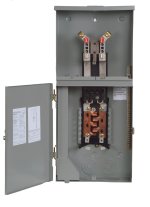I've only seen kirk keys used on large air frame switchgear substations, and or high voltage switches where you have primary / secondary select, where a transfer switch won't work or it would be overly expensive in money, time and space to make it work.
The whole purpose of kirk keys is to ensure you open / close breakers in the proper sequence, so that you can't make the dumb mistake. In other words, they are there to force the safety of the system.
Don't know if they make them for residential equipment. But if they did, you would put one on your generator breaker, and one on your main breaker. The generator breaker would normally be locked open, without a captive key. without the key, you can not close the generator breaker. The main breaker would be closed, with the kirk key captive in that position but not locked closed, the breaker is free to be opened.
In this situation, the only way to close the generator breaker, is to open the main breaker, lock the main breaker open with the kirk key, which then allows the key to be released from the lock. You now move the key to the generator breaker, unlock the kirk key, which now captures the key, and you manually can close the generator breaker. In this state, you have the generator breaker closed, they key is captured and can not be released until you open the generator breaker. The main breaker is locked open, with no key to allow you to close it. In no way does the kirk key system prevent a breaker from opening on overcurrent. It only controls when you can manually open/close a breaker.
This is a forced break before make situation, to guarantee you don't screw it up and backfeed the main with your generator.
In my past usage, we did the opposite, we would force a make before break, to ensure you didn't accidently open the load. This was done on double ended substations with a tie breaker, with synced sources.
For the homeowner, a transfer switch is the way to do it. I have never backfed my panel from a generator, but I would be comfortable doing it. I don't recommend it to anyone. Some power companies now offer a connector at the meter to hook up a generator, that essentially is a transfer switch. You can buy make before break transfer switches, but they need to have the equipment to sync to the source before it will close. Way too expensive for the average homeowner.
Hopefully this clears up some of the misunderstandings of how kirk keys work, and that they are there for safety.

